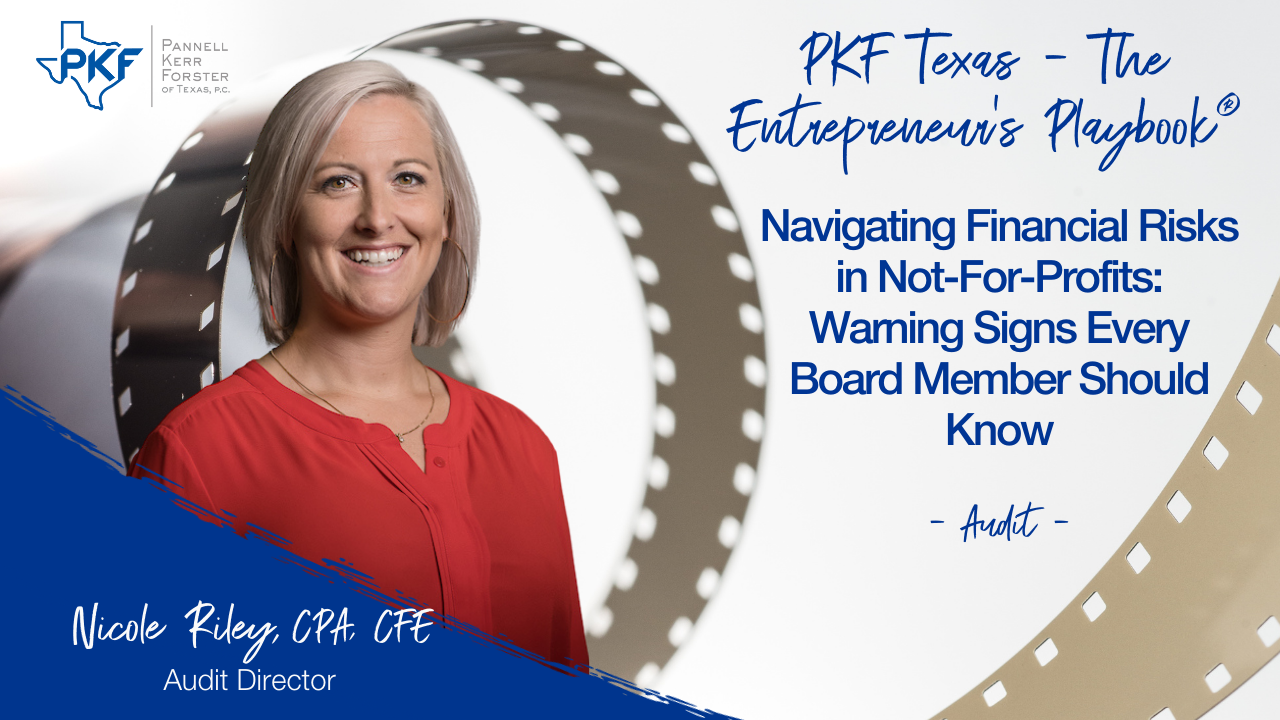Navigating Financial Risks in Not-For-Profits: Warning Signs Every Board Member Should Know

Join Jen Lemanski and audit director, Nicole Riley, CPA, CFE in this episode of the PKF Texas – The Entrepreneur’s Playbook®, where they discuss crucial warning signs for board members in not-for-profit organizations. From unexplained budget variances to downward trends in contributions, learn how to spot red flags in your organization’s financial health and make informed decisions.
Jen: This is the PKF Texas Entrepreneur’s Playbook, I’m Jen Lemanski, and I’m back once again with Nicole Riley, one of our Approachable Advisors® and one of the leads of our not-for-profit team here at PKF Texas. Nicole, welcome back to the Playbook.
Nicole: Hi. Nice to be here.
Jen: Not-For-Profits have boards. And so, they have a fiduciary duty to pay attention to financials, pay attention to what the health of the organization. What types of warning signs should board members be looking for when they receive the financials or when they’re in these board meetings, what should they be looking for?
Nicole: Yeah, so right now things are kind of getting a little iffy with the economy and people are starting to be concerned and there’s a huge amount of things that you should be aware of, but I think there’s like four that I really wanted to dive into today. The first and foremost being unexplained budget variances. The board and management went through the process to do a budget, and the budget is supposed to be how the organization wants their money to be spent and where they expect the money to come from. That should have been a thought-out process. So, if the results are not in line with the budget, there should be reasonable explanations of why it’s not in correspondence. So, if management is unable to explain those variances, or they can’t quite figure out why there are variances, I think that’s the first big red flag for a board member to stop and take a deeper dive and kind of start to peel back the onion there.
Jen: And they should be getting those financials at least once a month. Correct?
Nicole: Correct. And if they’re not getting financials timely or they’re not getting financials that are reliable.
Jen: It’s also a red flag.
Nicole: That would be the next red flag for sure. Having financial results that, you know, whether it’s a lot of audit adjustments that you receive at year end so that the financial results that you saw on a monthly basis are significantly different than what’s getting reported in the audit. That would be a huge red flag for me. Or if things change from month to month, like if they’re having to backdate or having, they weren’t completely closed, or they do the closing entries after the board sees the financials. Those are all things that I think are concerning when it comes to reviewing the financial statements and knowing how the organization is doing. Because the board uses the financial statements to make decisions and to weigh the pros and cons. And you can’t make good business decisions if you don’t have good numbers.
Jen: So, what other things should they be looking for?
Nicole: I think the other two things that I wanted talk about was one downward trend in your contributions. So, if you’re starting to hear things from donors where they’re not going to, you know, if they’ve been a donor for many years and they’re no longer going to renew their contributions, or if you just have this overall trend of reduced contributions to the organization, I think the board needs to take that seriously and talk to development and see what’s going on. See why donors are no longer wanting to support the mission. If there is maybe a lack of communication with the donors, that they don’t really know what the successes are, if you’re not tracking your successes to be able to see those kinds of things. Or donor communications. Like there could be all sorts of things in that bucket of worms, if you will, to start trying to figure out. But I think just if you start to see a downward trend in your contribution levels year over year, starting to look at why that’s happening, what’s going on in, that’d be the next layer of the onion you need to peel to that back.
And then the final thing I wanted to kind of talk about, the big red flag is if you start seeing management not following the policies of the organization and the procedures that the board has put in place. The executive director and the management team need to have the autonomy to run the organization, but they should not essentially run amok, you know? They shouldn’t be exceeding the expense approvals that the board has provided, they should be going through the proper approval procedures when that’s necessary or if they’re taking out debt and that wasn’t approved by the board. Those are all things that are huge red flags to either the organization’s not doing as well as we thought it was or mismanagement or a whole lot of things that could really be going on that the board needs to be concerned about and figure out what’s going on and why that’s happening.
Jen: Well, that sounds really interesting. And so, if a board member sees some of these red flags, who should they be talking to about them?
Nicole: If it’s possible, I think the executive director, the management team, needs to be the first because they’re the ones that need to implement the strategies and be putting things into place to help get the organization to the next level. If that’s not happening and that’s not either, maybe the board needs to consider a change in management or having a third party, consultants, advisors coming in to help explain what’s going on, take a deeper dive, kind of maybe be their boots on the ground to provide them with some additional information to help them figure out their next steps.
Jen: Perfect. That makes sense. Well, we’ll get you back to talk about some more things impacting not-for-profits. Sound good?
Nicole: Sounds great.Jen: This has been another Thought Leader production, brought to you by PKF Texas – The Entrepreneur’s Playbook®. For more information about this and other topics, visit pkftexas.com/insights. Tune in next week for another chapter.

